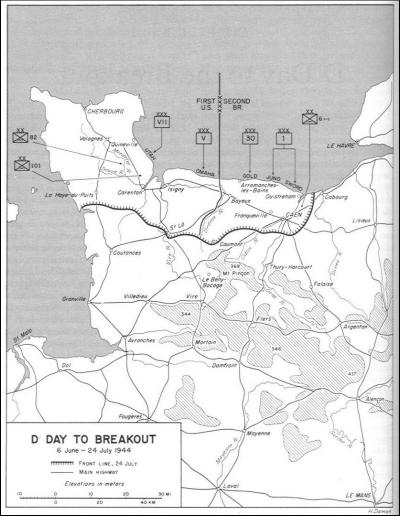World War II: War on the Western Front
World War II: War on the Western Front
 The Western Front of the European Theatre of World War II encompassed Denmark, Norway, Luxembourg, Belgium, the Netherlands, France, and west Germany. The Western Front was marked by two phases of large-scale ground combat operations. The first phase saw the capitulation of the Low Countries and France during May - June, 1940, and consisted of an air war between Germany and Britain that climaxed during the Battle of Britain. The second phase consisted of large-scale ground combat, which began in June 1944 with the Allied landings in Normandy and continued until the defeat of Germany in May 1945.
The Western Front of the European Theatre of World War II encompassed Denmark, Norway, Luxembourg, Belgium, the Netherlands, France, and west Germany. The Western Front was marked by two phases of large-scale ground combat operations. The first phase saw the capitulation of the Low Countries and France during May - June, 1940, and consisted of an air war between Germany and Britain that climaxed during the Battle of Britain. The second phase consisted of large-scale ground combat, which began in June 1944 with the Allied landings in Normandy and continued until the defeat of Germany in May 1945.
In May 1940, the Germans launched the Battle of France. The Western Allies - primarily the French, Belgian and British land forces - soon collapsed under the onslaught of the so-called "blitzkrieg" method. Strong elements of British and French forces escaped at Dunkirk, while the French Army returned to France via Normandy to surrender with 90,000 dead and 200,000 wounded. Fighting along the Front ended. The Germans began to consider ways of resolving the question of how to deal with Britain. If the British refused to agree to a peace treaty, one option was to invade. However, the German Navy (Kriegsmarine) had suffered serious losses in Scandinavia, and in order to even consider an amphibious landing, Germany's Air Force (the Luftwaffe) had to first gain air superiority or air supremacy.
On June 6th, 1944, the Allies began Operation Overlord (also known as "D-Day") - the long-awaited liberation of France. The deception plans, Operation Fortitude and Operation Bodyguard, had the Germans convinced that the invasion would occur at the Pas-de-Calais, while the real target was Normandy. Following two months of slow fighting in hedgerow country, Operation Cobra allowed the Americans to break out at the western end of the lodgement. Soon after, the Allies were racing across France. They circled around and trapped 250,000 Germans in the Falaise pocket. As had so often happened on the Eastern Front Hitler refused to allow a strategic withdrawal until it was too late. 100,000 Germans managed to escape through the Falaise Gap but they left behind most of their equipment and 150,000 were taken prisoner.
The Allies had been arguing about whether to advance on a broad-front or a narrow-front from before D-Day. If the British had broken out of the Normandy bridge-head around Caen when they launched Operation Goodwood and pushed along the coast, facts on the ground might have turned the argument in favour of a narrow front. However, as the breakout took place during Operation Cobra[clarification needed] at the western end of the bridge-head, the 21st Army Group that included the British and Canadian forces swung east through Belgium, the Netherlands, and Northern Germany, while the U.S. Twelfth Army Group advanced to their south via eastern France, Luxembourg and the Ruhr Area, rapidly fanning out into a broad front. As this was the strategy favoured by supreme Allied commander Eisenhower and most of the rest of the American high command, it became the strategy which was adopted.
|







 The Western Front of the European Theatre of World War II encompassed Denmark, Norway, Luxembourg, Belgium, the Netherlands, France, and west Germany. The Western Front was marked by two phases of large-scale ground combat operations. The first phase saw the capitulation of the Low Countries and France during May - June, 1940, and consisted of an air war between Germany and Britain that climaxed during the Battle of Britain. The second phase consisted of large-scale ground combat, which began in June 1944 with the Allied landings in Normandy and continued until the defeat of Germany in May 1945.
The Western Front of the European Theatre of World War II encompassed Denmark, Norway, Luxembourg, Belgium, the Netherlands, France, and west Germany. The Western Front was marked by two phases of large-scale ground combat operations. The first phase saw the capitulation of the Low Countries and France during May - June, 1940, and consisted of an air war between Germany and Britain that climaxed during the Battle of Britain. The second phase consisted of large-scale ground combat, which began in June 1944 with the Allied landings in Normandy and continued until the defeat of Germany in May 1945.